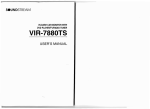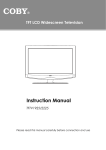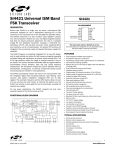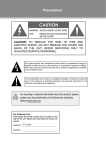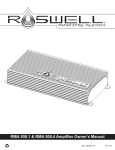Download Palsonic TFTV-151 User's Manual
Transcript
OWNER'S MANUAL TFTV-151 15.1" TFT LCD Monitor TV Palsonic Corporation Pty Ltd 1 Joynton Avenue WATERLOO NSW 201 7 AUSTRALIA Tel 61 2 93137111 Fax 61 293137555 www.palsonic.com.au Customer Service - 1300 657 888 Contents Safety Instructions ................................................................... General safety precautions ..................................................... 3 4 Parts Description Front Panel .......................................................................... Rear Panel ........................................................................... Remote Control Unit ............................................................ 5 6 7~8 MENU TREE .............................................................................. Connecting a PC ...................................................................... Viewing a PC screen Initial set PC mode ............................................................... When the picture is unstable ................................................ Adjusting the Picture settings ............................................... Adjusting the Sound settings ................................................ Adjusting the Geometry settings .......................................... PC Stable Adjustment .......................................................... Connecting to watch TV or VCR Connecting the Aerial or Cable Television Network ............... Connecting the VCR, DVD or Other External Devices ........... 9 10 11 11 12 13 14 15 16 16 Viewing a TV/VCR screen Adjusting the Picture Settings 1,2 ........................................ 17~18 Adjusting the Sound Settings 1,2 ......................................... 19~20 Channel Memory (PAL System) 21 Storing the Channel Automatically ....................................... 22~23 Storing the Channel Manually .............................................. 24 Fine Tuning Channel Reception .......................................... 25 Skipping Unwanted Channels .............................................. Other Functions Sleep ................................................................................... Recall ................................................................................... Surround .............................................................................. 26 26 26 Appendix Power Saver .................................................................... 26 Troubleshooting ............................................................... 27-28 Specification .................................................................... 29 Display Modes ................................................................. 30 Congratulations on your purchase of this Palsonic Product. We recommend that you thoroughly read this manual before use to fully enjoy the many functions and excellent features of this set. Retain this manual in an easily accessible location for future reference. 2 Safety Instructions Before connecting the AC power cord to the DC adapter outlet, make sure the voltage designation of the DC adapter corresponds to the local electrical supply. Never insert anything metallic into the cabinet openings of the Liquid Crystal Display (LCD) monitor: doing so may create the danger of electric shock. To avoid electric shock, never touch the inside of the LCD monitor. Only a qualified Technician should open the case of the LCD monitor. Never use your LCD monitor if the power cord has been damaged. Do not allow anything to rest on the power cord, and keep the cord away from areas where people can trip over it. Be sure to hold the plug, not the cord, when disconnecting the LCD monitor from an electric socket. Openings in the LCD monitor cabinet are provided for ventilation. To prevent overheating, these openings should not be blocked or covered. Also, avoid using the LCD monitor on a bed, sofa, rug, or other soft surface. Doing so may block the ventilation openings in the bottom of the cabinet. If you put the LCD monitor in a bookcase or some other enclosed space, be sure to provide adequate ventilation. Put your LCD monitor in a location with low humidity and a minimum of dust. Do not expose the LCD monitor to rain or use it near water (in kitchen, near swimming pool, etc.). If the LCD monitor accidentally gets wet, unplug it and contact an authorised dealer immediately. You can clean the LCD monitor with a damp cloth when necessary, but be sure to unplug the LCD monitor first. Place the LCD monitor on a solid surface and treat it carefully. The screen is made of thin glass with a plastic front surface and be damaged if dropped, hit or scratched. Do not clean the front panel with keton-type materials (e.g., acetone), ethyl alcohol, toluene, ethylacid, methyl, or chloride - these may damage the panel. Locate your LCD monitor near an easily accessible AC outlet. CAUTION RISK OF ELECTRICAL SHOCK DO NOT OPEN CAUTION: TO REDUCE THE RISK OF ELECTRICAL SHOCK, DO NOT REMOVE COVER (OR BACK). NO USER-SERVICEABLE PARTS INSIDE. REFER SERVICING TO QUALIFIED SERVICE PERSONNEL. 3 General safety precautions This Monitor has been engineered and manufactured to assure your safety. You can prevent serious electrical shock and other hazards by keeping in mind the following: Do not place anything heavy, wet or magnetic on the monitor or the power cord. Never cover the ventilation openings with any material and never touch them with metallic or inflammable materials. Avoid operating the monitor in extreme heat, humidity or areas affected by dust. Temperature: 5-35°C Humidity: 30~80RH Be sure to turn the monitor off before plugging the power cord into the socket. Make sure that the power cord and the other cords are securely and correctly connected. Overloaded AC outlets and extension cords are dangerous, as are frayed power cords and broken plugs, which may cause electric shock or fire. Call your service technician for replacement. Do not use sharp tools such as a pin or a pencil near the monitor, as they may scratch the LCD surface. Do not use a solvent, such as benzene, to clean the monitor, as it will damage the LCD surface. 4 Parts Description Front Panel 1. SPEAKER 2. POWER switches the set off (stand-by mode) and on. 3. MENU display the main on-screen menu. Exit from sub-menu. 4. SELECT select input signal or select submenu of the on-screen menus. 5. Volume UP, Volume DOWN adjust the volume. Also adjust the value of a menu option. 6. CH UP, CH DOWN change channels. Also used to highlight selections on the on-screen menus. Accessories Remote Controller DC power Supply/Adapter 15-pin D-Sub Signal Cable Power Cable 5 User's Manual Parts Description Rear Panel 1. AUDIO OUTPUT connects to the audio input port of an additional device. 2. VIDEO OUTPUT 3. AUDIO INPUT audio signals from VCR or similar device. 4. VIDEO INPUT video signals from VCR or similar device. 5. S-VIDEO IN S-Video signal from an S-VHS VCR or laser disc player. 6. HEAD PHONE JACK 7. SCART (PAL System) SCART audio/video connector. 8. POWER Jack to input DC power from power outlet. 9. PC VIDEO INPUT used to connect a video signal from a personal computer 10. PC AUDIO INPUT connects to the sound-output port of a personal computer. 6 Remote Control Unit 7 Inserting the Batteries in the Remote Controller You must insert or replace the batteries in the remote controller when you: Purchase the set. Find that the remote controller is no longer operating correctly. 1 Remove the cover of the remote controller by pressing the symbol and pulling the cover space in the direction of the arrow. 2 Insert 2 batteries (AAA size), Care about the polarities. 3 Replace the cover by pushing it in the direction of the arrow. ! You can use your remote controller within a distance of 7~10m and an angle of 30 degrees from the left and right sides of the remote controller receptor of your monitor. CAUTION Danger of explosion if battery is incorrectly replaced. Replace only with the same or equivalent type recommended by the manufacturer. 8 Menu Tree Main Menu PICTURE CONTRAST BRIGHTNESS SHARPNESS COLOR TEMP COLOR TINT SOUND (TV/VIDEO mode) (PC mode) (TV/VIDEO mode) (TV/VIDEO mode, NTSC System) TREBLE BASS BALANCE GEOMETRY (PC mode) S.MODE (PAL System) MTS (NTSC System) H-POSITION V-POSITION AUTO POSITION FUNCTION (PC mode) FUNCTION (TV mode, PAL System) TRACKING AUTO TRACKING INFORMATION CLOCK TUNING (Not available) LANGUAGE (PAL System) TRACKING (Not available) PHASE INFORMATION TUNING SPORT LANGUAGE AUTO TUNING MANUAL TUNING FINE TUNING CH SKIP FUNCTION (TV mode, NTSC System) TRACKING (Not available) INFORMATION AIR/CATV TUNING 9 Connecting a PC 1 Turn off your computer and monitor. 2 Connect a PC D-Sub cable between your PC and PC-VIDEO-IN of the monitor. And then fasten the screws of both sides of the cable. 3 Connect a PC Audio Cable between the Sound Output jack of the sound card on a PC and the PC-AUDIO-IN of the monitor. 4 Connect a DC Power unit cable to the Power jack on the rear of your monitor. And connect a power cable to the DC Power unit before connecting to a power outlet. 5 Power on the computer before turning on the monitor. 10 Viewing a PC screen Initial set PC mode 1 Power on your monitor by pressing the POWER button on the main set or on the remote controller. 2 Use the PC button on the remote controller to switch to the PC mode. Then the PC screen is automatically set. When a CD-Title runs, the music is output from speakers. (You can use an external speaker via the Audio Output jack on the rear of the main set.) 1 Press the MENU button and the PICTURE menu is displayed. 2 Use the VOL or VOL FUNCTION menu. 3 Use the CH or CH button to move to TRACKING, then press the SEL button. Then, the TRACKING menu will be displayed. 4 Move to AUTO TRACKING, then press the SELECT button. Then, the message “AUTO TRACKING PROCESSING ...” appears on the screen to stabilise the screen. 5 Press the MENU button repeatedly until the menus disappear. When the picture is unstable 11 button to move to the Viewing a PC screen Adjusting the Picture Settings Your monitor has several settings which allow you to control picture quality: CONTRAST, BRIGHTNESS, COLOUR TEMPERATURE 1 Press the MENU button. Result : The PICTURE menu is displayed. 2 Use the CH or CH buttons to select one of the following options: CONTRAST BRIGHTNESS COLOUR TEMPERATURE 3 Press the SEL button. 4 Press the VOL or VOL personal preference. buttons to suit your CONTRAST: Adjust the brightness and darkness between objects and back grounds. BRIGHTNESS: Adjust the overall of the screen brighter or darker COLOUR TEMPERATURE: The tone of colour can be changed from reddish white to bluish white. 5 Press the MENU button repeatedly until the menus disappear. 12 Viewing a PC screen Adjusting the Sound Settings The sound settings can be adjusted to suit your personal preference: TREBLE, BASS, BALANCE, S.MODE 1 Press the MENU button. Result: The PICTURE menu is displayed. 2 Use the VOL or VOL SOUND menu. buttons to move the 3 Use the CH or CH following options: TREBLE BASS BALANCE S.MODE 4 Press the SEL button. 5 Press the VOL or VOL personal preference. buttons to select one of the buttons to suit your S.MODE / MTS : To select STEREO or MONO 6 Press the MENU button repeatedly until the menus disappear. 13 Viewing a PC screen Adjusting the Geometry Settings The geometry settings can be adjusted to centre your viewing screen. 1 Press the MENU button. Result : The PICTURE menu is displayed. 2 Use the VOL , VOL GEOMETRY menu. 3 Use the CH or CH following options: H-POSITION V-POSITION AUTO POSITION 4 Press the SEL button. 5 Press the VOL or VOL position of screen. buttons to move the buttons to select one of the buttons to adjust the If the position of screen is horizontally off-centred, use H-POSITION. If the position of screen is vertically off-centred, use V-POSITION. Use the AUTO POSITION to position the screen to be horizontally and vertically centred automatically. 6 Press the MENU button repeatedly until the menus disappear. 14 Viewing a PC screen PC Stable Adjustment When the screen is unstable in PC settings, or to make your PC stable by adjusting the Clock and Phase, set the PC in the following sequence: 1 Press the MENU button. Result : The PICTURE menu is displayed. 2 Use the VOL , VOL FUNCTION menu. 3 Use the CH button move to TRACKING and then press the SEL button. Result: The TRACKING menu is displayed. 4 Use the CH or CH following options: AUTO TRACKING CLOCK PHASE buttons to select one of the 5 To adjust the.. AUTO TRACKING CLOCK PHASE Press the... SEL button. VOL or VOL VOL or VOL 6 7 buttons to move the button. button. AUTO TRACKING: Automatically optimises the status of screen. This is recommended to perform for new PC. CLOCK: Adjusts the horizontal size of screen by increasing / decreasing the number of pixels. PHASE: Sets the focus of screen. Adjusts when some noise exists or the character lines are seen overlapped. Press the MENU button repeatedly until the menus disappear. 15 Connecting to watch TV or VCR Connecting the Aerial or Cable Television Network To view television channels correctly, a signal must be received by the set from one of following sources: An outdoor aerial An indoor aerial (not recommendable) A cable television network 1. In the first three cases, connect the aerial or network input cable to the 75 ohm coaxial socket on the bottom of the television. 2. Press the TV mode button on the remote controller. Cable Television Network Connecting the VCR, DVD or Other External Devices 1. Connect video and audio cable according to the shape and colour of the video / audio cable. (SCART jack, RCA jacks) When an external devices is in MONO, the audio connection cable can be connected to either the left and S.MODE/MTS should be set FM MONO/MONO. 2. For optimal visual image, use S-VIDEO connector instead of video (yellow) connector. If RCA jack is connected together with SCART jack, RCA jack has priority. 16 Viewing a TV/VCR screen Adjusting the Picture Settings 1 Your TV have several settings which allow you to control picture quality: CONTRAST, BRIGHTNESS, SHARPNESS, COLOUR, TINT 1 Press the MENU button. Result: The PICTURE menu is displayed. 2 Use the CH or CH following options: CONTRAST BRIGHTNESS SHARPNESS COLOUR TINT (NTSC System) 3 Press the SEL button. 4 Press the VOL or VOL personal preference. 5 Press the MENU button repeatedly until the menus disappear. 17 buttons to select one of the buttons to suit your Adjusting the Picture Settings 2 By pressing the P.STD button on the remote control, you can sequentially select any one of the four possible preferred analogue picture presets. Whenever this button is pressed, the mode will be changed as follows. CUSTOM STANDARD STRONG MOVIE SOFT CUSTOM Select this mode to view the adjusted picture you want. STANDARD Select this mode to view the factory - presetting standard picture. STRONG Select this mode to - view a powerful and clear picture. - watching in the brighter (daylight) environments. MOVIE Select this mode to view a DVD or Video picture. SOFT Select this mode - to emphasize mildness. - when it is dark around. - to lessen the fatigue of eyes 18 Viewing a TV/VCR screen Adjusting the Sound Settings 1 The sound settings can be adjusted to suit your personal preference: TREBLE, BASS, BALANCE, S.MODE / MTS 1 Press the MENU button. Result: The PICTURE menu is displayed. 2 Use the VOL ,VOL SOUND menu. 3 Use the CH or CH buttons to select one of the following options: TREBLE BASS BALANCE S.MODE (PAL System) MTS (NTSC System) 4 Press the SEL button. 5 Press the VOL or VOL buttons to suit your personal preference. S.MODE : description below (PAL System) buttons to move the Type of broadcast Regular broadcast (Standard audio) Regular + NICAM Mono NICAM Stereo On-screen lndlcation Mono (Normal use) Mono Nicam Mono (Normal) NICAM Stereo Stereo Nicam Mono (Normal) NICAM Dual-I/II Dual-I Nicam Dual-II Mono Nicam (Normal) Regular broadcast (Standard audio) A2 Stereo Bilingual or Dual-I/II Stereo Mono (Normal use) Dual-I Dual-II Stereo Mono (Forced Mono) MTS: To select STEREO, SAP or MONO (NTSC System) 6 Press the MENU button repeatedly until the menus disappear. 19 Adjusting the Sound Settings 2 By pressing the S.STD button on the remote control, You may get more best sound and change the sound of a suit with a video source. Whenever this button is pressed, the mode will be changed as follows. CUSTOM STANDARD MUSIC MOVIE SPEECH CUSTOM Select this mode to listen the adjusted sound you want. STANDARD Select this mode to listen the factory - presetting standard sound. MUSIC Select this mode to listen the music video or the live picture source. MOVIE Select this mode to listen the movie sound. SPEECH Select this mode to listen the TV news or the TV talk-shows, etc. 20 Channel Memory (PAL System) Storing the Channels Automatically You can scan the frequency ranges available on your television in your country and store all the channels found automatically. The channels are stored in the order in which they appear in the frequency bands. It is possible that the automatically allocated numbers may not correspond to those by which you wish to identify the channels. If this is the case, you can then sort them manually. 1 Press the MENU button. Result: The PICTURE menu is displayed. 2 Press the VOL button to place the selection bar on the FUNCTION menu. 3 Press the CH button to place the selection bar on the TUNING mode. And press the SEL button. 4 Press the CH button to place the selection bar on the AUTO TUNING and press the SEL button. 5 Press the CH button, set the broadcasting system. (PAL/ SECAM or SECAM L) and press SEL button. Result: The AUTO TUNING will store found channel automatically. White the AUTO TUNING is progressing, the TV will change channels up to 99. When searching and storing is completed, the SORT menu is displayed. User can exchange favourite channels to preferred channel number. 6 Press the VOL or VOL channel is shown. 7 Press the CH button to place the selection bar on the TO option. Press the VOL or VOL until the new number by which you wish to identify the channel is displayed. 8 Press the CH button to place the selection bar on the store. Press the VOL or VOL button, the channel will stored in memory displaying OK for a moment. 9 When searching and storing is complete, press the MENU button repeatedly until the menus disappear. 21 button until favourite Channel Memory (PAL System) Storing the Channel Manually When storing channels manually, you can choose: whether or not store each of the channels found. The number by which you wish to identify each stored channel. 1 Press the MENU button. Result: The picture menu is displayed. 2 Use the VOL or VOL FUNCTION menu. 3 Press the CH or CH button to select the TUNING option and press the SEL button. Result: The tuning menu is displayed. 4 Press the CH or CH button to move the MANUAL TUNING and press the SEL button. 5 Press the VOL or VOL button repeatedly until the COLOR SYSTEM is best quality. Result: The COLOR SYSTEM is changed. PAL buttons to move the SECAM AUTO 6 Press the CH 7 Press the VOL or VOL button repeatedly until the SOUND SYSTEM is best quality Result: The sound system is changed. BG 8 Press the CH 22 button to move the SOUND. DK I L button to move the PR. NO Channel Memory (PAL System) 9 To assign a program number to the channel, press the VOL or VOL button until you find the correct number. 10 Press the CH 11 Press the VOL search. 12 When the screen is fine tuned, press the CH to move the STORE. 13 Press the VOL or VOL button, the channel will automatically stored in memory displaying OK for a moment. 14 Repeat steps 8~13 for each channel to be stored. 15 When you have finished manual storage, press the MENU button repeatedly to return to normal viewing. 23 button to move the SEARCH. or VOL button to start the button Channel Memory (PAL System) Fine Tuning Channel Reception If the reception is clear, you do not fine-tune the channel, as this is done automatically during the search and store operation. If however the signal is weak or distorted, you may have to fine-tune the channel manually. 1 Press the MENU button. Result: The PICTURE menu is displayed. 2 Use the VOL or VOL FUNCTION menu. 3 Press the CH or CH button to select the TUNING option and press the SEL button. Result: The tuning menu is displayed. 4 Press the CH or CH button to move the FINE TUNING and press the SEL button. 5 When a channel is right viewed by using the VOL or VOL buttons, the Tuning is automatically set. 6 Press the MENU button repeatedly until the menus disappear. 24 buttons to move the Channel Memory (PAL System) Skipping Unwanted Channels You can exclude the channels of your choice from the channel scan operation. When you scan through the stored channels, those you have chosen to skip are not displayed. 1 Press the MENU button. 2 Use the VOL or VOL FUNCTION menu. 3 Press the CH or CH button to select the TUNING option and press the SEL button. Result: The tuning menu is displayed. 4 Press the CH or CH button to move the CH SKIP and press the SEL button. 5 Press the CH or CH required channel. 6 To add or erase the desired channel by pressing the VOL or VOL VOL :ERASE, VOL :ADD 7 Press the MENU button repeatedly until the menus disappear. 25 buttons to move the button to select the Other Functions SLEEP You don’t have to remember to switch the set turn off before you go to sleep. The sleep timer automatically switches the set to stand-by after the preset time elapses. For selecting you desired number of minutes, press the SLEEP button several times or Continuously. OFF will appear on the screen, followed by 10, 20, 30, 60, 90, 120, 150, and 180. NOTE: 1. To view the remaining sleep time, press the SLEEP button once. 2. To cancel the sleep time, repeatedly press the SLEEP button until the display SLEEP OFF appears. 3. When you switched the set turn off, the set released the preset sleep time. RECALL Press RECALL button on the remote control. The number of TV channel or the video mode you are now viewing, will display on the screen. SURROUND You can select the special surround effect sound. Press SURROUND button, you may get surround effect sound and will display SURROUND ON, on the screen. If you don’t want this effect, press again SURROUND button then you may get normal sound and will display SURROUND OFF. APPENDIX A: Power Saver This monitor has a built-in power management system called Power saver. This system saves energy by switching your monitor into a low-power mode when it has not been used for a certain period of time. The available modes are "On", "Stand-by", "Sleep" and "Deep Sleep". Power Saver operates with a VESA DPMS compliant video card installed in your computer You use a software utility installed on your computer to set up this feature. See below table for details. Power-Saving Function mode (EPA / ENERGY 2000) S:rate Normal Operation Standby Mode Sleep Mode Position A1 Deep Sleep Mode Position A2 Horizontal Sync Vertical Sync Video Active Active Active Inactive Active Blanked Active Inactive Blanked Inactive Inactive Blanked Power Indicator Green Amber Amber Blinking (0.5 sec interval) Amber Blinking (1 sec interval) Less than 3W Less than 3W Less than 3W Power Consumption 30W (Max.) NOTE: This monitor automatically returns to normal operation when horizontal and vertical sync return. This occurs when you move the computer’s mouse or press a key on the keyboard. 26 APPENDIX B: Troubleshooting If you have a problem setting up or using your LCD monitor, you may be able to solve it yourself. Before contacting customer service, try the suggested actions that are appropriate to your problem. What you see... Screen is blank and power indicator is off "CHECK CABLE OR SIGNAL" message “INVALID MODE" message Suggested Actions . . . . . Ensure that the power cord is firmly connected and the LCD monitor is on. Connecting a PC, page 13. Ensure that the signal cable is firmly connected to the PC or video sources. Ensure that the PC or video sources are turned on. Connecting a PC, TV or VCR, Page 12, 18. Check the maximum resolution and the frequency of the video adaptor. Compare these values with the data in the Display Modes Timing Chart. PC Stable Adjustment, page 19. APPENDIX D: Display Modes page 33. BRIGHTNESS, page 15, 20. CONTRAST, page 15, 20. The image is too light or too dark . Adjust the Brightness and Contrast. Horizontal bars appear to flicker, jitter or shimmer on the image . . Adjust the Clock function. Auto Tracking will clear it automatically. Vertical bars appear to flicker, jitter or shimmer on the image. Screen is blank and power indicator light is steady amber or blinks every 0.5 or 1 seconds . . . . .. Image is not stable and may appear to vibrate Image is not centred on the screen. .. . . . Reference PC Stale Adjustment. page 18. Adjust the Phase function and then adjust the Clock function. Auto Tracking will clear it automatically. The monitor is using its power management system. Move the computer’s mouse or press a key on the keyboard. APPENDIX A : Power Saver, page 33. Auto tracking will clear it automatically Check that the display resolution and frequency from your PC or video board is an available mode for your monitor. On your computer check : Control Panel, Display, Settings PC Stable Adjustment, page 18. Horizontal frequency Vertical frequency Maximum refresh rate Auto Position will set the best position automatically Adjust the horizontal and vertical position. 27 31KHz - 69KHz 56Hz - 85Hz 1024 x 768 @85Hz AUTO POSITION, page 17. H-POSITION, page 17. V-POSITION, page 17. APPENDIX B: Troubleshooting Suggested Actions Problem . No sound . . Sound level is too low Sound is too high pitched or too low pitched . . . . Ensure that the audio cable is firmly connected to both the audio-in jack on your monitor and the audio-out jack on your sound card. Reference Connecting a PC, TV or VCR, page 13, 19. Check the volume level Check the volume level If the volume is still too low after turning the control to its maximum, check the volume control on the computer sound card or software program. Adjust the Treble and Bass to appropriate level. Ensure that the antenna cable is firmly connected to the VHF/UHF jack. Adjusting the Sound settings, page 16, 21. Refer to your computer, sound card or software documentation. Adjusting the Sound Settings, page 16, 22. Connecting to watch TV or VCR, page 19. Check "Channel Memory" and make sure you choose the correct channel system. (PAL Model) TV signal is not received Channel Memory, page 25, 26. . . Select "Auto Tuning" to configure the channel system automatically. (PAL Model) Check AIR/CATV is correctly selected on screen display menu. (NTSC Model) 28 Selecting Broadcast Source, page 29 APPENDIX C: Specification MONITOR FUNCTION LCD Panel Input / Output TV (PAL model) Type 15.1" TFT AM LCD Display Area 307.2mm x 230.4mm Display Colour 16,777,216 (8-bit) Pixel Pitch 0.3mm x 0.3mm Max. Resolution XGA 1024 x 768 (@85Hz) Interface TTL / TMDS Viewing Angle 120 degrees horizontal / 90 degrees vertical Contrast Ratio 350 : 1 (typical) Brightness 400cd/m 2 Physical Rotation +30 degrees Up, -5 degrees Down Horizontal Frequency 31 ~ 69KHz Vertical Frequency 56 ~ 85Hz Dimension 384(W) mm x 378(H) mm x 57(D) mm Video input PC Analog RGB A/V, S-Video, SCART A/V, S-Video PC Audio PC Audio, A/V, S-Video, SCART PC Audio, A/V, S-Video USA Audio Input Audio Output Monitor Out Area None EU (Except France), Australia Antenna Input None 75 Coaxial Cable Tuning System None Programmable Frequency Synthesizer Colour System None PAL/SECAM, NTSC NTSC Sound System None B/G, D/K, I M VHF Low None E2Ch(48.25MHz)~ S10Ch(168.25MHz) 1Ch(91.25MHz)~ C22Ch(165.25MHz) VHF High None E5Ch(175.25MHz)~ S41Ch(463.25MHz) 4Ch(171.25MHz)~ C38Ch(313.25MHz) UHF None E21Ch(471.25MHz)~ E69Ch(885.25MHz) 13Ch(471.25MHz)~ 62Ch(765.25MHz) Teletext None Optional None Safety UL, CSA, FCC, CE, CCIB, EIAJ EMI CE, C-Tick Power Output Stand-by: 3Watt / Operation: 45Watt Speaker 3W (PMPO) x 2EA Plug & Play Level DDC 1/26 Weight NET 4.8Kg/ Gross 7.3Kg Power Supply DC 12V, 5A, 50/60Hz TV Signal Tuning Range Regulation Other TV (NTSC model) Specification can be changed without prior notice. 29 APPENDIX D: Display Modes If the signal from the system equals to the standard signal mode, the screen is adjusted automatically. If the signal from the system doesn’t equal to the standard signal mode, adjust the mode with referring to the Video card user guide because the screen might not display or only the power LED might be on. For the display modes listed below, the screen image has been optimised during manufacturing. Mode VGA SVGA XGA Resolution Horizontal Frequency (KHz) Vertical Frequency (Hz) Pixel Clock Frequency (MHz) Sync Polarity (H/V) 720 x 400 31.469 70.087 28.322 -/+ 640 x 480 31.469 59.940 25.175 -/- 640 x 480 37.500 75.000 31.500 -/- 640 x 480 43.269 85.008 36.000 -/- 800 x 600 46.875 75.000 49.500 +/+ 800 x 600 53.674 85.061 56.250 +/+ 1024 x 768 48.363 60.004 65.000 -/- 1024 x 768 60.023 75.029 78.750 +/+ 1024 x 768 68.677 84.997 94.500 +/+ 30 PALSONIC CORPORATION PTY LTD 1 JOYNTON AVENUE WATERLOO NSW 2017 AUSTRALIA TEL:(02)9313 7111 FAX:(02)9313 7555 www.palsonic.com.au PALSONIC CUSTOMER SERVICE TELEPHONE AUSTRALIA: 1300 657 888 KQFIT201Z7
































